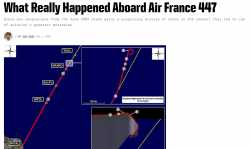>>1751558I hate to make the comparison, but technology can be great in an emergency.
US Airways Flight 1549 featured a bird strike with loss of both engines. The captain took control of the aircraft with the very clear instruction, "My airplane". Positive transfer of control.
With the loss of both engines, the plane entered Alternate Law 2. Many protections were lost, but the plane still maintained its angle of deflection flight controls. NTSB investigators concluded that the Airbus fly by wire system helped the captain safely ditch in the river.
Air France Flight 447 featured the pilots choosing to fly right into a tropical storm over the South Atlantic Ocean. A British Airways B777 chose to fly north of the storm to Heathrow. A Lufthansa A340 chose to fly south of it.
The Air France crew chose to fly right into it.
Following an encounter with St. Elmo's Fire, the pitot tubes froze.
This resulted in a loss of indicated airspeed which disabled the Autopilot and also placed the plane into Alternate Law 1. The Pilot Flying immediately took manual control of the plane without stating he was doing so.
Neither pilots performed the Unreliable Airspeed memory items. Neither pilots even consulted the QRH for the Unreliable Airspeed checklist.
The Pilot Flying immediately started pulling back on the flight controls to pitch up. After doing this for some time, the Stall Warning sounded.
Instead of pitching down and throttling up, the pilot flying chose to ignore the stall warning and continued to pitch up.
The Captain sat in the jump seat and allowed the First Officer and Second Officer to keep flying.
When the captain noticed the altitude was decreasing, the second officer decided to start pitching down with the side stick, triggering the Dual Input warning.
None of the pilots practiced positive transfer of control and continued to dual input until crash.

